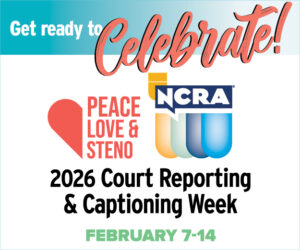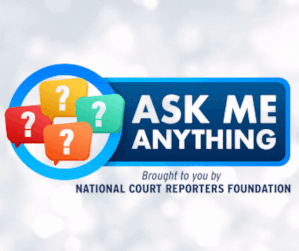
By Sheri Smargon
I realtimed a job a couple years ago for a writers’ national literary conference holding their annual convention in Tampa Bay, Fla., where I live. I was contacted by the Disabilities Coordinator for the group after he did a search of the NCRA Sourcebook to find a local CART provider. The group needed someone to provide one-on-one CART to a member who is Deaf. The job was going to take place at our convention center downtown. As hinted to by the name, the location would be large.
My consumer would be attending four or five breakout sessions per day, but that schedule was subject to change. The agenda I was given only listed the name of the author giving the talk and the title of the book of which they would be speaking. Since I didn’t know which seminars my consumer would be attending, I prepped for every seminar and every topic before I went onsite. I made a dictionary and added names, titles, and any words from any of the authors’ autobiographies that I could find.
On day one of the seminar, I arrived on site about an hour and a half early. I wasn’t exactly sure where I needed to go, but I needed to assess the setup and the best place for me to sit so I could be inobtrusive yet still able to hear the speakers. I learned quickly that I should wear flats the next day, as the heels I had chosen on the plush, lush carpet made for a great leg workout.
I found the on-site Disability Coordinator when I arrived, and they told me where and what my consumer’s seminars for the day would be. I would start in Ballroom A, move to Ballroom C, back to Ballroom A, and finally to Ballroom D for the final seminar. I then had to think logistically the best way to get all of my equipment from ballroom to ballroom in the 15 minutes between seminars. Luckily, Ballroom D’s seminar was after lunch, so I had a bit of time to move and reacclimate.
I determined that sitting at the very front of the room off to the side would work best for me in most of the ballrooms. I was closest to an electrical plug. and I could use a few of the participants’ chairs to create a makeshift desk area. I set up five iPad minis on the chairs next to me. Granted, there was only one consumer that I knew of, but I wanted to ensure there were no tech issues with any of the equipment they needed to use. I set up my steno machine, my Cooltable to hold my laptop, plugged everything in, tested all my equipment, and waited for my consumer. She arrived, introduced herself, gave me her cell phone number to communicate, then wandered off to find a seat, iPad in hand.
Because I use Stenograph’s iCVNet, I was able to provide the iPad and my consumer could sit anywhere in the room she wanted to. I couldn’t get reliable internet access in the convention center, so I used my personal router to stream to the iPads. Seminar one went off without a hitch. My consumer brought my iPad back and said she would see me in the next seminar. So I quickly packed up all my gear, laying my open laptop on top of my steno bag, wrapping cords with a bungee wrap so I don’t trip while moving, “throwing” my iPads into my steno bag and hustled over to the next ballroom.
Seminar two — well, there started the fun. It turned out the seminar presenter had taken up my scoped-out seat site and had friends in the area I had chosen. So I sat at the back of the room for this job. Not my wisest move, as it turned into an impromptu panel discussion with people in the audience. They were all speaking with their backs to me. To do a good job, I decided to leave my computer and setup where it was and move just my steno machine and move closer within the audience, where I could hear better. Luckily, these seminars were only an hour and a half each, but they all ended with a question-and-answer session. Needless to say, I was tired at the end of session two, and I still had two more sessions to go.
At the end of session two, I moved back to Ballroom A for session three, and wash, rinse, repeat with the iPads, cords, cables, etc. That session ended, and it was lunchtime. I packed everything up for the fourth time that day and went to the last ballroom to set up my equipment. By doing that, I could relax for a bit during the lunch break, knowing I was ready to go when the session started.
After two days of this literary seminar, where I was exposed for the first time to people introducing themselves by name and the pronouns they would like people to use when referring to them (she, her/he, him) at warp speed, the last seminar of the day was the only one that had ASL interpreters in attendance. There were quite a few Deaf and HoH participants in the panel discussion. I gave my consumer an iPad, then offered the other participants who wanted one the few remaining iPads I had left. The discussion was fast, intense, and involved a lot of fingerspelling of cities in Africa. But in the end, I still learned something.
A couple weeks after the job, I received a handwritten card from my consumer, thanking me for the job I did. I had never received a handwritten thank-you before, and I was so incredibly flattered and humbled that I was able to help her fully experience the seminar. We don’t take these jobs for thanks, but when you know you provided quality and also learned something, it’s a win-win situation. When the consumer also thinks the same thing and lets you know, it doesn’t get any better.
Sheri Smargon, RDR, CRR, CRC, is a CART captioner and freelance court reporter based in Riverview, Fla. She can be reached at stenorpr@gmail.com.




[…] Reprinted here with permission of the JCR – Journal of Court Reporting, a publication of the National Court Reporters Association. This article was originally published in thejcr.com. […]